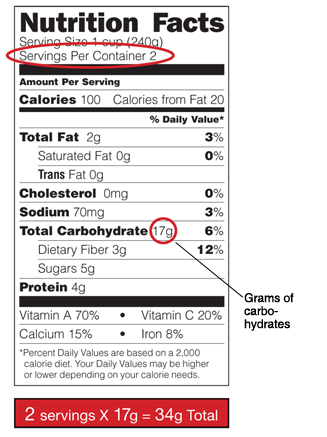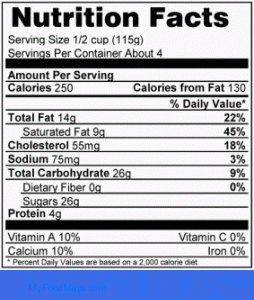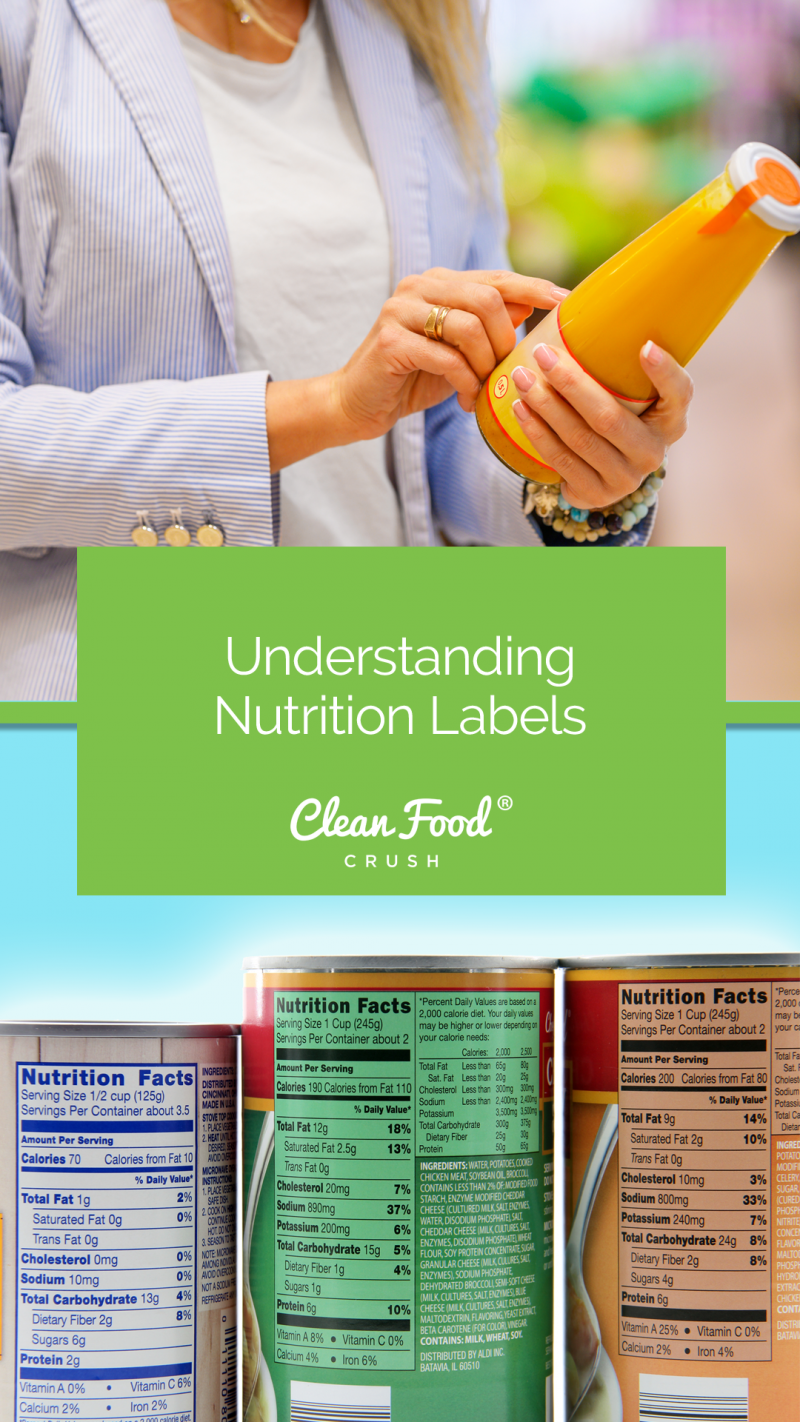38 reading nutrition labels carbohydrates
Carbohydrates - NZ Nutrition Foundation The Nutrient Reference Values set by the Ministry of Health recommends 45-65% of an adult's energy intake comes from carbohydrates, but less than half of adult Kiwis achieve this recommendation. Eating at least 6 servings of bread and cereals (preferably wholegrain i.e. not refined) and 5 servings of vegetables and 2 servings of fruit each ... What is a Nutrition Label? (with pictures) - Delighted Cooking A nutrition label is a federally mandated addition to any food product that is traded interstate. Carefully reading nutrition labels can help people stay informed about the foods they eat. A nutrition label is required on prepared foods such as breads, cereals, canned and frozen foods, snacks, desserts, and drinks.
The best high-protein foods for weight loss - Diet Doctor Most plain Greek yogurts contain about 15-18 grams of protein and 5 grams of carbs per 170-gram (3/4 cup) container. However, make sure to read nutrition labels, as protein and carb counts vary from brand to brand. Try Greek yogurt as a sour cream substitute, topped with chopped nuts, or simply enjoy its creamy goodness alone.

Reading nutrition labels carbohydrates
Basic Carbohydrate Counting - What You Need to Know Also read nutrition labels to find out how much carbohydrate is in the foods you eat. See "Total Amount of Carbohydrate" on the label for the amount. The amount of carbohydrate in the serving size listed on the package may be more than 15 g. Keep track of the amount of carbohydrate servings you have for each meal and snack. Levels 7 min read. Nutrition. The Explainer. What are the metabolic benefits of "free-range," "grass-fed," and "wild"? Which food labels matter? Here's what animal protein designations mean for our metabolic health and what experts have to say. ... Swap out a few refined-carb ingredients, and it's easy to create a flavorful meal and ... Foods to Avoid When You Have Heart Disease | MyHeartDiseaseTeam You can tell if a product has added sugars by reading the nutrition label. The label will list the total amount of sugar as well as any added sugars. The American Heart Association recommends women limit added sugars to 6 teaspoons (or 25 grams a day) and men limit added sugars to 9 teaspoons (or 36 grams a day). 4. Refined Carbohydrates
Reading nutrition labels carbohydrates. How athletes should really read nutrition labels - Multisport.ph That's around 50 to 75 grams of carbohydrates per hour. Most endurance athletes require 200 to 300 calories from carbohydrates per hour. That's around 50 to 75 grams of carbohydrates per hour Gels, sports drinks, and bars are the best option. However, other natural sources such as dried fruits are great as well. Rethink Your Drink | Healthy Weight, Nutrition, and Physical Activity | CDC Two hundred calories is about 12 teaspoons of added sugar in food and beverages combined. A 12-ounce regular soda has more than 10 teaspoons of added sugar, adding up to about total 150 calories. Cutting out 2 regular sodas per day would reduce total calories by 2,100 in a week. 9. How To Read Pet Food Labels & Ingredient Lists: Nutrition, and What To ... How To Read Pet Food Labels Nearly all pet foods will have this type of format on the label: Product of brand name. Quantity of the product (weight or volume). The guaranteed analysis or nutritional content. Ingredients in ascending order according to weight. Feeding directions. Manufacturer's certification and address. A calorie statement. 1. What Are Normal Blood Sugar Levels After Eating? The glycemic index, a carb ranking system that uses a scale ranging from zero to 100, helps you find out how foods impact your blood sugar levels. High index foods are quickly processed and can cause a rapid spike in blood sugar levels. Low index foods are more slowly processed. This tends to lead to smaller blood glucose changes. 4 Recap
Classification of Carbohydrates - New Health Advisor Carbohydrates are usually classified into three broad categories: sugars, starches, and fiber. Sugars are simple carbohydrates like glucose, fructose and lactose. They cause a rapid rise in blood glucose levels. Starches are complex carbohydrates that are composed of several molecules of glucose. Nutrition Facts Label - IFT.org The Nutrition Facts Label, also referred to as the Nutrition Facts Panel, on packaged food and beverage products is intended to help consumers make informed food choices that contribute to a healthy diet. The first Nutrition Facts Label regulations were published in 1993 and launched in 1994. How to calculate net carbs vs. total carbs — Diet Doctor Strict low carb — less than 20 grams of net carbs (30 grams of total carbs) Moderate low carb — 20 to 50 grams of net carbs (30 to 70 grams of total carbs) Liberal low carb — 50 to 100 grams of net carbs (70 to 130 grams of total carbs) Our advice Focus on net carbs when eating whole, natural foods such as vegetables, fruit, beans, and legumes. Carbohydrates and Calories - jewishinphiladelphia.com Carbohydrates are the food molecules that make up food. Sugars are carbohydrate sources. There are two kinds of sugars: natural and added. Let's look at the caloric value of these two types of sugars. You may even find out how much of each you consume by reading this article. In addition, you can use the… Continue reading Carbohydrates and Calories
Five Food Myths and the Truth About Eggs, Carbohydrates, Canned Soups ... Be sure to read your labels. Carbohydrates should be avoided. Quite simply, NO. Carbohydrates are not bad for you. In fact, they are your body's preferred source of fuel and energy, and there is no need to avoid them. I do encourage you to make them a part of your well-balanced meals and snacks. ... Fat-free and low-fat food options are ... 5 Ways YOU Are Being Tricked with Misleading Food Labels Carbohydrates The net carbs are the total carbs with the total fiber subtracted. Your net carbs need to be below 50 g per day for keto. However, certain things like maltodextrin are listed under carbs instead of sugar—even though it acts like sugar. Reading a Nutrition Label When You Have Diabetes and Kidney Disease Carbohydrates Many people with T2D monitor their carbohydrate intake. Your doctor can tell you what amount of carbohydrates is recommended for you. Sugars There may be natural and added sugars in... Figuring Out Food Labels | HealthyPlace Carbohydrates are your body's primary source of energy. This total is broken down into grams of sugar and grams of dietary fiber. Protein This number tells you how much protein you get from a single serving of the food. Your body needs protein to build and repair essential parts of the body, such as muscles, blood, and organs.
All Diet & Nutrition Articles | Everyday Health Read on for the potential health benefits of this superfood, nutrition info, recipe inspiration, and more. By Valencia Higuera May 31, 2022 Daily Coffee Associated With Lower Risk of Early Death
Understanding Food Labels and Ingredient Lists: FAQs and Do's and Don'ts Fresh eggs. Foods with insignificant amounts of the nutrients on the required label, such as coffee, tea, spices, flavor extracts, and food colors. These may contain ingredient labels but are unlikely to contain nutrition facts labels. Packaged single-ingredient meat products, such as deer, bison, rabbit, quail, wild turkey, and ostrich.
A Snapchat Lens For Food Shopping - forbes.com Even reading food labels can be impractical while shopping. Our goal is to summarize trustworthy information to help shoppers make informed decisions quickly. The need for personalization
Nutrition | CDC Resources & Publications. Nutrition related Vital Signs, state reports, tools, and training. Micronutrients. Why vitamins and mineral matter and what CDC is doing globally. Healthy Food Environments. Programs and policies that make healthier foods more accessible, including promoting nutrition standards.
If You're Not Counting Your Macros Yet, Read This - CNET Each macronutrient corresponds to a specific calorie amount per gram: Carbohydrates have 4 calories per gram Proteins have 4 calories per gram Fats have 9 calories per gram How many macros should I...

The nutrition label shows the total amount of carbohydrates in grams. one gram of carbohydrates ...
Wake Up and Read the Labels! on Apple Podcasts [07:09] - How Carly navigated nutrition after her Olympic career. [09:10] - When Carly discovered Wake Up and Read the Labels [15:39] - What Carly shops for at the grocery store. [19:27] - What Carly wishes she had known sooner. [20:12] - One reason you should read the labels. [20:41] - Carly's Wake Up moment. Quotes
Glycemic index: A helpful tool for diabetes? - Mayo Clinic The glycemic index classifies carbohydrate-containing foods according to their potential to raise your blood sugar level. Foods with a high glycemic index value tend to raise your blood sugar higher and faster than do foods with a lower value. The glycemic index may have some benefits, but may have some problems too. Concerns include:
Here's how to read a nutrition label so you can make the best choices These include fats, carbohydrates, proteins, vitamins, minerals and water. All of these nutrients are classified as essential, and your body needs them to function properly. These nutrients need to...
Public Health Sudbury & Districts - Reading labels The 13 nutrients listed are: fat, saturated fat, trans fat, cholesterol, sodium, carbohydrates, fibre, sugars, protein, vitamin A, vitamin C, calcium and iron. The nutrition facts table can help identify foods that fit with your healthy eating goals, or help you identify foods that have more or less of a particular nutrient you want.
Nutrition Labelling Scheme - Centre for Food Safety The enactment of the Food and Drugs (Composition and Labelling) (Amendment: Requirements for Nutrition Labelling and Nutrition Claim) Regulation 2008 signifies a new era of food labelling in Hong Kong as most prepackaged food sold in Hong Kong have nutrition labelling from 1 st July 2010. Last revision date: 23 May 2022.

Five Things to Remember when Reading Nutrition Labels – Physical Education and Health Assessment
Foods to Avoid When You Have Heart Disease | MyHeartDiseaseTeam You can tell if a product has added sugars by reading the nutrition label. The label will list the total amount of sugar as well as any added sugars. The American Heart Association recommends women limit added sugars to 6 teaspoons (or 25 grams a day) and men limit added sugars to 9 teaspoons (or 36 grams a day). 4. Refined Carbohydrates
Levels 7 min read. Nutrition. The Explainer. What are the metabolic benefits of "free-range," "grass-fed," and "wild"? Which food labels matter? Here's what animal protein designations mean for our metabolic health and what experts have to say. ... Swap out a few refined-carb ingredients, and it's easy to create a flavorful meal and ...

The Ultimate Guide to Reading Food Labels in Japan | Surviving in Japan: (without much Japanese)
Basic Carbohydrate Counting - What You Need to Know Also read nutrition labels to find out how much carbohydrate is in the foods you eat. See "Total Amount of Carbohydrate" on the label for the amount. The amount of carbohydrate in the serving size listed on the package may be more than 15 g. Keep track of the amount of carbohydrate servings you have for each meal and snack.









Post a Comment for "38 reading nutrition labels carbohydrates"